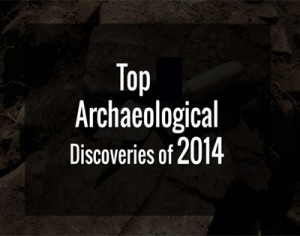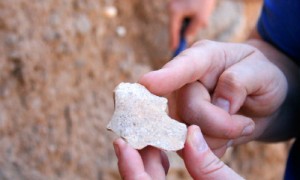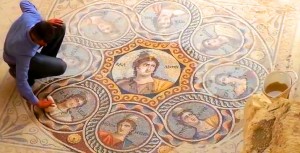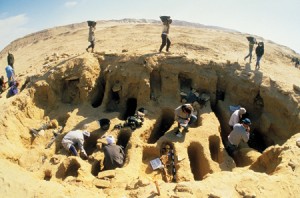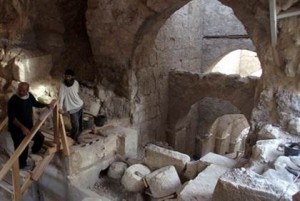Top Archaeological Discoveries of 2014
It’s been a mesmerizing year for archaeology around the globe, Ever since the innovation of the biggest known Greek tomb was announced in August, The Amphipolis tomb, which dates to the time of Alexander the Great, is a prime example of how archaeology can fascinate the public imagination.
Equally inspiring was the discovery, after decades upon decades of searching, of a ship that sank in Arctic waters in present-day Canada almost 170 years ago while looking for the Northwest way. That find was deemed so significant that Canadian Prime Minister Stephen Harper took it upon himself to make the official announcement.
Archaeologists were also hard at work in the lab squeezing as much imminent as possible out of limited proof. Analysis of 6,000-year-old funerary wrappings recognized that ancient Egyptians practiced artificial mummification much earlier than had been attention.
Genetic material from a skeleton found in an underwater cave in Mexico helped shed light on the connection between the first people to arrive in the Americas and modern Native Americans. And a clever approach to interpreting the genome of Neanderthals discovered factors beyond the raw genetic code that explain how they differed from recent humans.
This year’s finds span the globe and tens of thousands of years, but are united in indicating archaeology’s skill to uncover hidden truths. What better example than the revelation via remote-sensing technologies that Stonehenge is enclosed by thousands of yet-to-be-interpreted Neolithic archaeological features
Old Stone Tool discovered in Turkey is 1.2 million years old
Archaeologists have set up a Paleolithic stone flake in the ancient deposits of the Gediz River, revealing that human ancestors passed through the gateway from Asia to Europe much earlier than previously thought.
Although Paleolithic stone tools have been established in western Turkey before, few have been associated with geological deposits of known age. As a result, the timing of early humans’ development across the Anatolian peninsula is badly understood.
The newfound stone tool is composed mostly of quartz and is about 5 cm long.
It shows proof of being hammered by a hard tool and, according to the scientists, is at least 1.2 million years old.
“The flake was an extremely exciting find. I had been studying the sediments in the meander bend and my eye was drawn to a pinkish stone on the shell. When I turned it over for a better look, the features of a humanly-struck artifact were immediately apparent,” said Prof Danielle Schreve of Royal Holloway University of London, UK, who is a co-author of the paper published in the journal Quaternary Science Reviews.
“This discovery is significant for establishing the timing and way of early human dispersal into Europe.”
“Our research suggests that the flake is the earliest securely-dated artifact from Turkey ever recorded and was dropped on the floodplain by an early hominine well over a million years ago.”
Prof Darrel Maddy of Newcastle University, who is the guide author on the study, added: “although the find of an individual struck flake may not in itself be strange, the observation is significant because we can assign a precise time range to the relic and thus the presence of hominins.”
“We observed markings on the flake that obviously suggest it had been struck with force by a hard hammer or other stone tool, making it highly unlikely that it was created by natural processes.”
“This quartzitic flake was then dropped on the floodplain of a vigorous river meander. That meander cut through lavas with age estimates of 1.24 million years and was finally discarded as a response to damming of the river downstream by a younger lava flow dated to 1.17 million years.
“This makes it the initial securely-dated artifact from Turkey yet reported.”
The oldest hominin fossils in western Anatolia, attributed to Homo erectus, were improved in 2007 in the deposits of travertine at Kocabaş in the Denizli basin – about 100 km south of where the flake was discovered – but their dating were uncertain.
“This study highlights the need for geologists and archaeologists to work more intimately together,” Prof Maddy said.
“By doing so we should be able to track the actions of early humans with ever increasing detail, affording us great opportunities to understand the distribution of our ancestors and the origins of the first Europeans.”
Amazing Mosaics discovered in Ancient City of Zeugma
An international team of archaeologists has unearthed three 2,200-year-old, well-preserved glass mosaics at the site of the olden city of Zeugma in Turkey. The incredibly well preserved mosaics date back to the 2nd century BC, but they’re still as gorgeous as the first day.
The olden city of Zeugma, also known as Seleukia-on-the-Euphrates, is located in modern Gaziantep province, where the Euphrates River rounds its utmost bend to the west and begins to flow south into the Syrian Desert.
It was discovered in 300 BC by Seleucus I Nicator – one of the generals of Alexander the Great – who named the city after himself.
In 64 BC the city was occupied by the Roman Empire and with this shift the name of the city was changed into Zeugma.
Across the Taurus Mountains from Anatolia and across the Euphrates from Mesopotamia, the city was forever between large cultural forces, but never entirely part of any one.
The city is well known for its construction, which spans centuries and gives a peek into Hellenistic and Roman civilization on the Euphrates frontier.
Zeugma mosaics have long been known for their exquisite detail and beauty. One of the most famous is the Gypsy Girl.The team led by Prof Kutalmis Görkay of Ankara University unearthed three remarkably whole glass mosaics at the site.The first depicts the nine Muses – the goddesses of the motivation of literature, science and the arts. Muse Calliope is in the center of the mosaic.
The second mosaic depicts Ocean – the divine image of the sea – and his sister Tethys. The third, smaller in size mosaic, depicts a young man.
According to the team, all mosaics are constructed of colored glass and served as floors of a construction that archaeologists have dubbed the House of Muses.
Ancient Egyptian Cemetery with One Million mummified bodies found
American archaeologists are excavating a graveyard in Egypt that could enclose over a million mummified bodies.
The leftovers of more than 1,700 people have already been unearthed in the graveyard, which is known as Fag el-Gamous and is located about 96 kilometers south of Cairo in the Faiyum region. Judging by the density of the burials and the large size of the cemetery, the archaeologists consider that it could have over a million bodies.
The mummies appear to be those of common people, rather than dignitaries, who were buried around 1,500 years ago, when Egypt was controlled by the Roman and Byzantine empires. The people covered in the cemetery had few goods covered with them and were laid in the ground without coffins.
The bodies, which were physically mummified by the hot and dry desert conditions, were buried in deep shafts cut into the limestone rock. The depth of some of the shafts exceeds 30 meters.
The archeologists, who come from Brigham Young University in Provo, Utah, are mystified by the origin of all the bodies. A village that has been exposed nearby would have been too small to warrant such a large cemetery and the nearest town, named Philadelphia after King Ptolemy II Phiadelphus, has its own burial sites.
Bizarrely, the mummies emerge to be clustered together by hair color, with those with blond hair in one area and those with red hair in another.
Among the recent discoveries made last year were the mummified leftovers of a little girl aged around 18 months old, still with two jewels on each arm, and a woman with long blonde hair.
Quite a few of our mummies had excellent teeth, something that is unusual,” said project director Professor Kerry Muhlestein.
The excavation site is also home to the small Seila pyramid, which researchers consider may be the second or third true pyramid ever constructed.
Muhlestein said it was constructed by Snerfu, the former king of the fourth dynasty who discovered how to build a true pyramid after his predecessors built step pyramids for generations.
Though the cemetery was first exposed some 30 years ago, excavation has been speeded-up due to encroachment by local farmers expanding their cultivable area.
The BYU team is now creating a database with information about burials, burial goods and textiles like mummy wrappings. Researchers hope to conduct a demographic study to learn more about the lifetime of people in the area, including infant and child mortality rates.
Muhlestein said it can be hard to learn about the common man because they aren’t very visible in written sources, but findings from the cemetery can provide insight into what life was like.
2,000-year-old Palace Entryway to Herod’s hilltop palace discovered
Hebrew University of Jerusalem archaeologists have exposed a huge and sophisticated entryway to the Herodian Hilltop Palace at Herodium National Park in Judea, south of Jerusalem.
The recently discovered entryway is amazing in that it features a complex system of arches on three separate levels, allowing the King and his entourage to directly enter the Palace Courtyard. Thanks to the arches, the 20-meter long and six-meter wide corridor has held up above the nearly 2,000 years since it was built at a height of 20 meters.
Archaeologists Roi Porat, Yakov Kalman and Rachel Chachy worked on the excavations that were conducted over the past year as part of The Herodium journey in Memory of Ehud Netzer, a project in memory of the university’s famed professor who found the tomb of Herod the Great and passed away in 2010 after being wounded in a fall at the Herodium site.
According to the three archaeologists who unearthed the find, the corridor was built by King Herod (73-4 BCE) as part of his plan to turn the Herodium site into a castle palace. However, the dig found proof that the corridor was never really used; as Herod apparently was aware he was nearing his death and changed the hilltop complex into a burial monument instead.
The corridor obviously was put on the back-burner at the end of Herod’s reign, with a massive stairway in fact built over it at the time. Not only was the arched corridor built over, but in fact the excavators found indications that other structures built earlier by Herod on the hill’s slopes with the Royal Theater were given a similar treatment.
In fact, the only finding that was not enclosed over during construction was Herod’s fancy mausoleum-style burial-place.
By detection the corridor entryway, the unique Palace vestibule was also exposed in all its glory, replete with painted frescoes. Also found was evidence, such as Jewish Revolt coinage and temporary structures, testifying to how Jews fighting the cruel Roman occupation in the Great Revolt used the site.
Evidence of a later rebellion was also found in the corridor, in the form of hidden tunnels dug on the site during the Bar Kokhba Revolt by Jewish rebels as part of their guerilla fighting against the Romans.
These tunnels, which were moderately supported by wooden beams, exited the fortress through the walls in openings hidden in the passage.
Shaul Goldstein, Director of Israel’s Nature and Parks Authority, said that in the future the corridor will be used to permit visitors to directly access the Herodium palace-fortress in the same way Herod entered it around 2,000 years ago.
